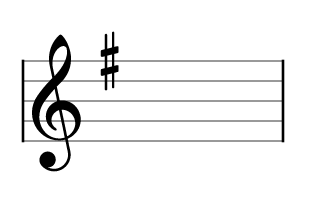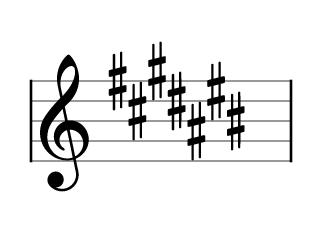OK, wtf is this?

Ugh, so many sharps. Eventually you learn them by heart. Like – but of course one sharp is G major. Also e minor. But to get there you need some tools. The circle of fifths is one such tool. But you need to move on from there. You don’t have time to draw a circle (even in your mind) every time.
So this post gives you two ideas to figure out key signatures without resorting to the circle.
Majors with sharps: raise half a step
Back to the example. What on earth can this possibly be? And let’s start with majors first.

You know how to traverse the circle of fifths and go F (forget it), C is 0, G is 1, D2, A3, E4, B5. Aha – B major!
But here’s a quicker way. Look at the last sharp. It’s A♯. Raise it by half step. Here’s your answer – B major.
Yup, that simple. Raise the last ♯ half a step. And bear the sharp in mind. You’re raising A♯ not A.
Wanna try another?

What is the last sharp? F♯. Raise it by half a step. G major. Boom!
Another? With all the sharps?

The last sharp is B♯ (same pitch as C). Raise is by half? C♯. There you go.
Nice, it works! How about the minors?
Minors with sharps: lower a step
A minor key has the same flats and sharps as the major which is a step and a half above it. A minor has 0 sharps and flats, just like C major. E minor has one sharp like G major. Theoretically if you know your majors you can derive the minor, just lower it a step and a half. But that’s doing two things. There’s a shortcut where you only do one thing. Fewer possible points of failure.
Take the last ♯ and lower it a whole step. Makes sense, right? For the majors you raise half a step and and the distance between a major and minor is a step and a half. 1.5 - 0.5 = 1
So let’s try.

F♯. Lower it a whole step – E. Answer: E minor.
Nice, gimme another!

The last sharp is B♯. Lower a step. A♯. Here’s your answer. A♯ minor.
Finally…

A♯ is the last. Down a step – G♯. G♯ minor – last and final answer.